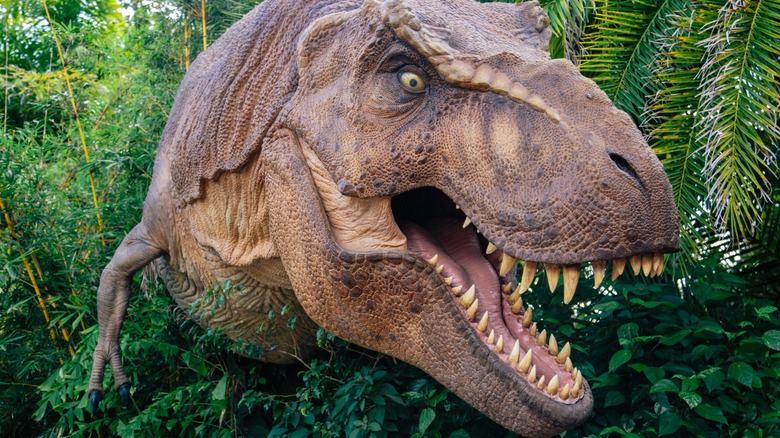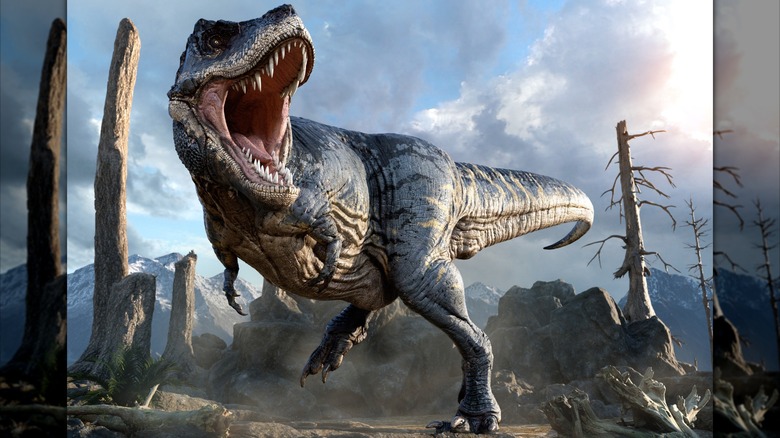The Truth About What The Tyrannosaurus Rex Really Looked Like
Dinosaurs were some of the most formidable creatures on Earth when they roamed the planet 66 to 245 million years ago. Films have done a great job at making these animals look as terrifying as possible, but the depiction hasn't been totally accurate. For instance, Steven Spielberg's "Jurassic Park" didn't depict what velociraptors really looked like — spoiler: they had feathers. The same can be said about the film's portrayal of the Tyrannosaurus rex's appearance (although, it isn't the only movie to get it wrong). As paleontologists have discovered remnants of these creatures and their relatives, though, they've been able to piece together what they might have actually looked like.
The biggest differences that scientists have pointed out are colors and patterns. More specifically, the lack of colors and patterns — solid or two-toned grays, greens, and taupes — that you usually see in photos and movies aren't consistent with reptiles in general. Modern-day reptiles, for instance, tend to feature blues, reds, and yellows with camouflage patterns, such as leopard spots or stripes.
In the 2018 BBC documentary "The Real T. Rex with Chris Packham," scientific evidence was gathered to reconstruct an accurate model of what a T. rex really looked like. Evidence of melanin — the same pigment that's in bird feathers and human skin — was found in dinosaur samples, indicating that the specimen likely had black, brown, and gray patches all over its body, much like predatory birds. Also like birds, there was evidence of bony ridges around the eyes, which suggests that the T. rex had bright orange or yellow coloring on its head which it may have used for social cues. Along with being more colorful, sample analyses of the dinosaur's close relatives point to it having feather-like bristles from the top of its head and down its back.
More things you think you know about the T. rex that are wrong
Steven Spielberg's "Jurassic Park" and many other works have gotten it right that the Tyrannosaurus rex was a massive creature. While it's theorized that most of these beasts were fewer than 12 meters (39 feet) long and weighed between 5 and 7 tons, some specimens have measured around 13 meters (42 feet) long and are estimated to have weighed about 8.5 tons. However, the general depictions might have gotten a couple of other characteristics wrong as well.
In "Jurassic Park," for example, the dino's top teeth are sharp and visible even when its mouth is closed. In "The Real T. Rex with Chris Packham," paleontologist Greg Erickson explains that, although the creature's teeth were the largest of any other dinosaur, they were blunt on the tip. The teeth had serrations on the front and the back, allowing the T. rex to crush and cut through bones and flesh simultaneously. Meanwhile, a study published in Science found that the dinosaur and other theropods had lips more like a Komodo dragon than a crocodile.
Another discrepancy is the speed of an adult T. rex. Studies using biomechanical models have found that, even at peak fitness, the animal could only safely maintain a running pace of 10 mph. Despite its giant size, it relied more on stealth and the element of surprise. So, if the T. rex was alive today, you might actually be able to outrun it, unlike the movie monster that could run down a car. On top of that, what the T. rex really sounded like was even more terrifying than what you hear in movies. Think the call of an ostrich mixed with the rumble of a crocodile, but lower and more ominous. No thank you.

